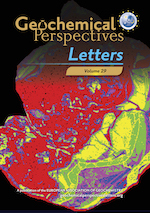Secular variability in zircon phosphorus concentrations prevents simple petrogenetic classification
Affiliations | Corresponding Author | Cite as | Funding information- Share this article





-
Article views:143Cumulative count of HTML views and PDF downloads.
- Download Citation
- Rights & Permissions
top
Abstract
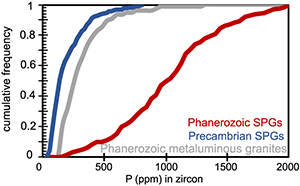
Figures
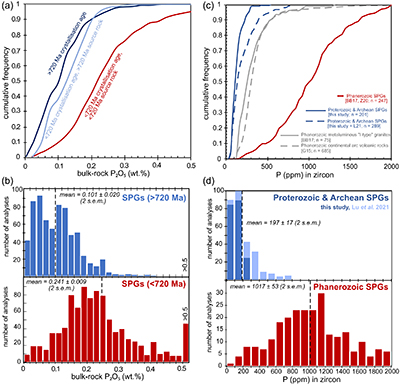 Figure 1 (a) Cumulate frequency distributions of SPG bulk rock P2O5. (b) Histograms of SPG bulk rock P2O5 with source rock and crystallisation ages >720 Ma (top) and <720 Ma (bottom). Data in (a) and (b) from Bucholz (2022). (c) Cumulative frequency distributions of P in zircon for Proterozoic and Archean SPGs, as well as Phanerozoic SPGs, “I-type” granites, and continental arc volcanic rocks. (d) Histograms of zircon P concentrations for Proterozoic/Archean SPGs and Phanerozoic SPGs. Phanerozoic SPG and I-type granite data in (c) and (d) are from Burnham and Berry (2017) and Zhu et al. (2020) and continental arc volcanic zircon from Grimes et al. (2015). | 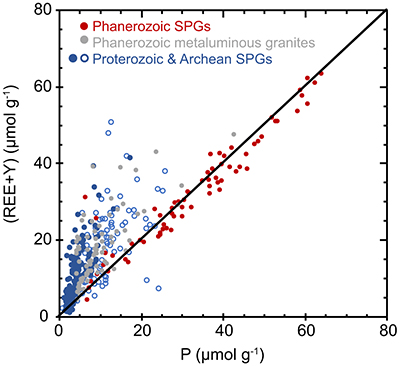 Figure 2 REE + Y versus P (in μmol/g) in zircon. Phanerozoic granite data are the same as in Figure 1. Proterozoic and Archean SPGs are from this study (filled symbols) and Lu et al. (2021) (open symbols). | 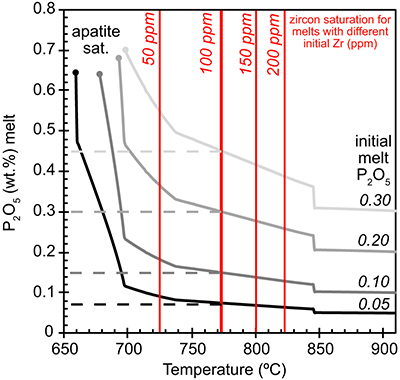 Figure 3 Model results for melt P2O5 (wt. %) versus temperature during crystallisation of a SPG melt for different initial melt P2O5 (wt. %). Melt trajectories end once apatite saturation is reached. Zircon saturation temperatures are indicated with vertical red lines. |
| Figure 1 | Figure 2 | Figure 3 |
top
Introduction
Trace element concentrations in zircon are used to “fingerprint” the magma from which they crystallised (e.g., Grimes et al., 2015
Grimes, C.B., Wooden, J.L., Cheadle, M.J., John, B.E. (2015) “Fingerprinting” tectono-magmatic provenance using trace elements in igneous zircon. Contributions to Mineralogy and Petrology 170, 46. https://doi.org/10.1007/s00410-015-1199-3
). Of particular interest is identification of zircon from “I-type” or metaluminous granites versus those from “S-type” or strongly peraluminous granites (SPGs1; Burnham and Berry, 2017Burnham, A.D., Berry, A.J. (2017) Formation of Hadean granites by melting of igneous crust. Nature Geoscience 10, 457–461. https://doi.org/10.1038/ngeo2942
; Trail et al., 2017Trail, D., Tailby, N., Wang, Y., Mark Harrison, T., Boehnke, P. (2017) Aluminum in zircon as evidence for peraluminous and metaluminous melts from the Hadean to present. Geochemistry, Geophysics, Geosystems 18, 1580–1593. https://doi.org/10.1002/2016GC006794
). Understanding the relative contribution of zircon from metaluminous versus peraluminous granites throughout Earth’s history yields information on lithologic diversity and tectonic environments through time. SPGs dominantly form in collisional orogenic environments through the partial melting of sedimentary rocks (Nabelek, 2020Nabelek, P.I. (2020) Petrogenesis of leucogranites in collisional orogens. Geological Society, London, Special Publications 491, 179–207. https://doi.org/10.1144/SP491-2018-181
). Thus, their inferred presence (or absence) through time yields information on both tectonic regimes and the availability of sedimentary rocks to be recycled into magmas during orogenic cycles.One proposed proxy to discriminate zircon from metaluminous and peraluminous granites is phosphorus (P) concentrations in zircon (Burnham and Berry, 2017
Burnham, A.D., Berry, A.J. (2017) Formation of Hadean granites by melting of igneous crust. Nature Geoscience 10, 457–461. https://doi.org/10.1038/ngeo2942
). As the solubility of apatite increases with melt aluminium saturation index (Pichavant et al., 1992Pichavant, M., Montel, J.-M., Richard, L.R. (1992) Apatite solubility in peraluminous liquids: Experimental data and an extension of the Harrison-Watson model. Geochimica et Cosmochimica Acta 56, 3855–3861. https://doi.org/10.1016/0016-7037(92)90178-L
; Wolf and London, 1994Wolf, M.B., London, D. (1994) Apatite dissolution into peraluminous haplogranitic melts: An experimental study of solubilities and mechanisms. Geochimica et Cosmochimica Acta 58, 4127–4145. https://doi.org/10.1016/0016-7037(94)90269-0
), P concentrates in peraluminous melts during differentiation due to the lack of apatite precipitation (Bea et al., 1994Bea, F., Pereira, M.D., Corretgé, L.G., Fershtater, G.B. (1994) Differentiation of strongly peraluminous, perphosphorus granites: The Pedrobernardo pluton, central Spain. Geochimica et Cosmochimica Acta 58, 2609–2627. https://doi.org/10.1016/0016-7037(94)90132-5
), a trend contrary to that observed in metaluminous melts (Lee and Bachmann, 2014Lee, C.-T.A., Bachmann, O. (2014) How important is the role of crystal fractionation in making intermediate magmas? Insights from Zr and P systematics. Earth and Planetary Science Letters 393, 266–274. https://doi.org/10.1016/j.epsl.2014.02.044
). Indeed, Phanerozoic SPGs have significantly higher P2O5 (on average ∼0.25 wt. % and up to ∼1.5 wt. % P2O5; Bea et al., 1992Bea, F., Fershtater, G., Corretgé, L.G. (1992) The geochemistry of phosphorus in granite rocks and the effect of aluminium. Lithos 29, 43–56. https://doi.org/10.1016/0024-4937(92)90033-U
; Bucholz, 2022Bucholz, C.E. (2022) Coevolution of sedimentary and strongly peraluminous granite phosphorus records. Earth and Planetary Science Letters 596, 117795. https://doi.org/10.1016/j.epsl.2022.117795
; Fig. 1a,b) than metaluminous granites (which generally have <0.20 wt. % at bulk rock SiO2 > 65 wt. %). Further, upon apatite saturation, P concentrations are buffered at higher levels in peraluminous than metaluminous melts.
Figure 1 (a) Cumulate frequency distributions of SPG bulk rock P2O5. (b) Histograms of SPG bulk rock P2O5 with source rock and crystallisation ages >720 Ma (top) and <720 Ma (bottom). Data in (a) and (b) from Bucholz (2022)
Bucholz, C.E. (2022) Coevolution of sedimentary and strongly peraluminous granite phosphorus records. Earth and Planetary Science Letters 596, 117795. https://doi.org/10.1016/j.epsl.2022.117795
. (c) Cumulative frequency distributions of P in zircon for Proterozoic and Archean SPGs, as well as Phanerozoic SPGs, “I-type” granites, and continental arc volcanic rocks. (d) Histograms of zircon P concentrations for Proterozoic/Archean SPGs and Phanerozoic SPGs. Phanerozoic SPG and I-type granite data in (c) and (d) are from Burnham and Berry (2017)Burnham, A.D., Berry, A.J. (2017) Formation of Hadean granites by melting of igneous crust. Nature Geoscience 10, 457–461. https://doi.org/10.1038/ngeo2942
and Zhu et al. (2020)Zhu, Z., Campbell, I.H., Allen, C.M., Burnham, A.D. (2020) S-type granites: Their origin and distribution through time as determined from detrital zircons. Earth and Planetary Science Letters 536, 116140. https://doi.org/10.1016/j.epsl.2020.116140
and continental arc volcanic zircon from Grimes et al. (2015)Grimes, C.B., Wooden, J.L., Cheadle, M.J., John, B.E. (2015) “Fingerprinting” tectono-magmatic provenance using trace elements in igneous zircon. Contributions to Mineralogy and Petrology 170, 46. https://doi.org/10.1007/s00410-015-1199-3
.Consequently, assuming equivalent zircon-melt P partition coefficients for metaluminous and peraluminous granitic systems, zircons from SPGs should have higher P contents than those from metaluminous granitic melts (Burnham and Berry, 2017
Burnham, A.D., Berry, A.J. (2017) Formation of Hadean granites by melting of igneous crust. Nature Geoscience 10, 457–461. https://doi.org/10.1038/ngeo2942
). Indeed, P in zircons from Phanerozoic peraluminous versus metaluminous granites have higher P concentrations (means of 1017 ± 53 versus 312 ± 48 ppm (2 s.e.); Burnham and Berry, 2017Burnham, A.D., Berry, A.J. (2017) Formation of Hadean granites by melting of igneous crust. Nature Geoscience 10, 457–461. https://doi.org/10.1038/ngeo2942
; Zhu et al., 2020Zhu, Z., Campbell, I.H., Allen, C.M., Burnham, A.D. (2020) S-type granites: Their origin and distribution through time as determined from detrital zircons. Earth and Planetary Science Letters 536, 116140. https://doi.org/10.1016/j.epsl.2020.116140
; Fig. 1c,d). Further, P and REE + Y concentrations are strongly correlated in zircon from Palaeozoic SPGs, suggesting the incorporation of P, REE, and Y into the zircon lattice via the coupled xenotime-type mechanism [(Y, REE)3+ + P5+ = Zr4+ + Si4+]. Based on these observations it has been proposed that P > 750 ppm and (REE + Y) < 1.15*P are robust criteria for identifying zircon from peraluminous granites (Burnham and Berry, 2017Burnham, A.D., Berry, A.J. (2017) Formation of Hadean granites by melting of igneous crust. Nature Geoscience 10, 457–461. https://doi.org/10.1038/ngeo2942
).However, P2O5 concentrations in SPGs are not elevated above those of metaluminous granites throughout Earth history (Bucholz, 2022
Bucholz, C.E. (2022) Coevolution of sedimentary and strongly peraluminous granite phosphorus records. Earth and Planetary Science Letters 596, 117795. https://doi.org/10.1016/j.epsl.2022.117795
). Maximum and average P2O5 concentrations in SPGs derived from sedimentary rocks deposited after 720 Ma are elevated above those derived from older source rocks (Fig. 1a,b). This temporal variation mirrors a similar increase in P concentrations in marine siliciclastic sediments deposited after 720 Ma, related to increased atmospheric and marine O2 levels and enhanced authigenic P burial (Reinhard et al., 2017Reinhard, C.T., Planavsky, N.J., Gill, B.C., Ozaki, K., Robbins, L.J., Lyons, T.W., Fischer, W.W., Wang, C., Cole, D.B. and Konhauser, K.O. (2017) Evolution of the global phosphorus cycle. Nature 541, 386–389. https://doi.org/10.1038/nature20772
). After considering the factors affecting P concentrations in SPGs, Bucholz (2022)Bucholz, C.E. (2022) Coevolution of sedimentary and strongly peraluminous granite phosphorus records. Earth and Planetary Science Letters 596, 117795. https://doi.org/10.1016/j.epsl.2022.117795
concluded that the temporal change in P concentrations is most likely explained as reflecting higher P concentrations in younger sedimentary source rocks. Elevated P concentrations in SPGs derived from sedimentary rocks deposited after 720 Ma could reflect both higher melt P concentrations and/or inherited P-rich restitic minerals (e.g., apatite, monazite, or P-bearing silicates).If P concentrations in Archean and most Proterozoic SPGs are relatively low and if this, to some degree, represents lower melt P concentrations, zircon crystallising from such melts may record these low P concentrations. To test this hypothesis, we analysed trace element concentrations (including P) in zircon from Meso- to Paleoproterozoic and Archean SPGs.
1We prefer the use of strongly peraluminous granite over “S-type” granites as the former is purely a geochemical definition that avoids confusion associated with the “alphabet” granite classification scheme (c.f., Frost et al., 2001
Frost, C.D., Da Prat, F.A. (2021) Petrogenetic and tectonic interpretation of strongly peraluminous granitic rocks and their significance in the Archean rock record. American Mineralogist 106, 1195–1208. https://doi.org/10.2138/am-2022-8001
). However, we emphasise that the SPGs discussed here have all been previously demonstrated to have formed via the partial melting of metasedimentary rocks.top
Studied Samples and Methods
We analysed trace elements in zircon (n = 201 analyses) from 16 previously characterised SPGs (Liebmann et al., 2021a
Liebmann, J., Spencer, C.J., Kirkland, C.L., Bucholz, C., He, X., Santosh, M., Xia, X.P., Martin, L., Evans, N.J. (2021a) Emergence of continents above sea‐level influences sediment melt composition. Terra Nova 33, 465–474. https://doi.org/10.1111/ter.12531
,bLiebmann, J., Spencer, C.J., Kirkland, C.L., Bucholz, C.E., Xia, X.-P., Martin, L., Kitchen, N., Shumlyanskyy, L. (2021b) Coupling sulfur and oxygen isotope ratios in sediment melts across the Archean-Proterozoic transition. Geochimica et Cosmochimica Acta 307, 242–257. https://doi.org/10.1016/j.gca.2021.05.045
) from the southwestern USA (ca. 1.4 Ga), the North China Craton (ca. 1.9 and 2.5 Ga), Finland (ca. 1.8–1.9 Ga), and Ghana (ca. 2.2 Ga) (see Tables S-1 and S-2 for locality, lithologic, and bulk rock major elements). The average bulk rock P2O5 contents of these SPGs are 0.088 ± 0.036 wt. % (2 s.e.). U-Pb isotopes and trace elements (Ca, P, Y, Hf, and REEs) were collected simultaneously using split stream laser ablation inductively coupled plasma mass spectrometry at UC Santa Barbara. Full analytical details are given in the Supplementary Information (SI) and sample and standard analyses are given in Tables S-4 and S-5, respectively. Cathodoluminescence imaging and U-Pb ages were used to ensure analysis of magmatic zircon (i.e. related to the crystallisation of the SPG) and not inherited cores/grains (Fig. S-1). Any analyses of inherited cores (with older U-Pb ages) or with >5 % discordance of U-Pb ages were excluded. No apatite inclusions were observed. We are aware of only one other locality of >720 Ma SPGs where trace elements in magmatic zircon were analysed (Lu et al., 2021Lu, G.-M., Spencer, C.J., Tian, Y., Wang, W. (2021) Significant Increase of Continental Freeboard During the Early Paleoproterozoic: Insights From Metasediment‐Derived Granites. Geophysical Research Letters 48, e2021GL096049. https://doi.org/10.1029/2021GL096049
) and include these data in our discussion.top
Results
The P concentrations in Archean and Proterozoic SPGs are positively skewed (average = 132 ± 10 (2 s.e.) ppm; median =110 ppm; and including Lu et al. (2021)
Lu, G.-M., Spencer, C.J., Tian, Y., Wang, W. (2021) Significant Increase of Continental Freeboard During the Early Paleoproterozoic: Insights From Metasediment‐Derived Granites. Geophysical Research Letters 48, e2021GL096049. https://doi.org/10.1029/2021GL096049
data, average =196 ± 17 ppm; median = 138 ppm). In comparison, P concentrations in zircon from Phanerozoic SPGs are normally distributed with an average of 1017 ± 53 (2 s.e.) (Fig. 1c,d). Cumulative frequency distributions of P concentrations highlight this difference (Fig. 1c) and the mean P concentration in zircon from Precambrian and Phanerozoic SPGs are statistically distinguishable (P < 0.00001, Wilcoxon rank sum test). Zircon REE + Y concentrations from Precambrian SPGs, although weakly correlated with P (R2 = 0.63), are defined by a slope of >1.15, distinct from the Phanerozoic SPG trend (Fig. 2). Neither P nor total REE concentrations correlate with Ca concentrations, suggesting that P concentrations are not reflecting the incorporation of apatite inclusions in the ablation volume.
Figure 2 REE + Y versus P (in μmol/g) in zircon. Phanerozoic granite data are the same as in Figure 1. Proterozoic and Archean SPGs are from this study (filled symbols) and Lu et al. (2021)
Lu, G.-M., Spencer, C.J., Tian, Y., Wang, W. (2021) Significant Increase of Continental Freeboard During the Early Paleoproterozoic: Insights From Metasediment‐Derived Granites. Geophysical Research Letters 48, e2021GL096049. https://doi.org/10.1029/2021GL096049
(open symbols).top
What Do Zircon P Concentrations Represent?
The P concentration of zircon reflects equilibrium and/or disequilibrium processes during crystallisation from melt, including (1) equilibrium partitioning dependent on temperature, pressure, and melt composition, (2) partitioning reflecting melt-crystal boundary layer concentrations controlled by diffusion of P in the melt, or (3) surface controlled non-equilibrium growth (e.g., Watson and Liang, 1995
Watson, E.B., Liang, Y. (1995) A simple model for sector zoning in slowly grown crystals; implications for growth rate and lattice diffusion, with emphasis on accessory minerals in crustal rocks. American Mineralogist 80, 1179–1187. https://doi.org/10.2138/am-1995-11-1209
; Hofmann et al., 2009Hofmann, A.E., Valley, J.W., Watson, E.B., Cavosie, A.J., Eiler, J.M. (2009) Sub-micron scale distributions of trace elements in zircon. Contributions to Mineralogy and Petrology 158, 317–335. https://doi.org/10.1007/s00410-009-0385-6
). In the first scenario, assuming that P partitioning is both Henrian and that equilibrium between zircon and melt occurred, then lower P concentrations in zircon from Archean/Proterozoic versus Phanerozoic SPGs could reflect either lower P concentrations in their parental melts or different conditions of crystallisation (e.g., melt composition, pressure, and temperature) which resulted in variable zircon-melt P partition coefficients. Phosphorus partitioning between melt and zircon as a function of melt composition, temperature, and pressure is poorly understood with limited experimental studies available (Rubatto and Hermann, 2007Rubatto, D., Hermann, J. (2007) Experimental zircon/melt and zircon/garnet trace element partitioning and implications for the geochronology of crustal rocks. Chemical Geology 241, 38–61. https://doi.org/10.1016/j.chemgeo.2007.01.027
; Taylor et al., 2015Taylor, R.J.M., Harley, S.L., Hinton, R.W., Elphick, S., Clark, C., Kelly, N.M. (2015) Experimental determination of REE partition coefficients between zircon, garnet and melt: a key to understanding high- T crustal processes. Journal of Metamorphic Geology 33, 231–248. https://doi.org/10.1111/jmg.12118
). However, Archean/Proterozoic SPGs are thought to have formed under similar conditions (e.g., pressure, temperature) to those in the Phanerozoic (Bucholz and Spencer, 2019Bucholz, C.E., Spencer, C.J. (2019) Strongly Peraluminous Granites across the Archean–Proterozoic Transition. Journal of Petrology 60, 1299–1348. https://doi.org/10.1093/petrology/egz033
). Thus, in the first scenario of equilibrium partitioning, the simplest explanation is that lower P concentrations in zircon from Archean/Proterozoic SPGs, as compared to Phanerozoic ones, reflect lower melt P concentrations.In the second scenario, the growth rate of zircon approaches (or exceeds) the diffusivity of P (and/or REE) in the adjacent melt. For hydrous rhyolites (∼6 wt. % H2O), experimentally calibrated P and Zr diffusivities (D) are similar with log(DP) and log(DZr) between −13.5 to −14.5 m2/s at 750–850 °C (see review of Zhang and Gan, 2022
Zhang, Y., Gan, T. (2022) Diffusion in Melts and Magmas. Reviews in Mineralogy and Geochemistry 87, 283–337. https://doi.org/10.2138/rmg.2022.87.07
). However, when zircon growth is sufficiently fast, P due to its general incompatibility is excluded from the zircon and builds up in a melt boundary layer. Thus, the growth of new zircon in equilibrium with this boundary layer acquires higher P concentrations elevated above that predicted by equilibrium partitioning with the bulk (i.e. far field) melt. However, all else being equal (e.g., P diffusivity and partition coefficients), melts with higher bulk P concentrations would produce boundary layers with higher P concentrations which would be reflected in higher zircon P concentrations.Finally, in the third scenario, unequivocable evidence for surface controlled, non-equilibrium growth manifests as sector zoning (Watson and Liang, 1995
Watson, E.B., Liang, Y. (1995) A simple model for sector zoning in slowly grown crystals; implications for growth rate and lattice diffusion, with emphasis on accessory minerals in crustal rocks. American Mineralogist 80, 1179–1187. https://doi.org/10.2138/am-1995-11-1209
), however (sub-)μm scale oscillatory variations P concentrations have also been attributed to non-equilibrium growth (Hofmann et al., 2009Hofmann, A.E., Valley, J.W., Watson, E.B., Cavosie, A.J., Eiler, J.M. (2009) Sub-micron scale distributions of trace elements in zircon. Contributions to Mineralogy and Petrology 158, 317–335. https://doi.org/10.1007/s00410-009-0385-6
). We generally avoided analysing portions of zircon that exhibited sector zoning (Fig. S-1). However, when analysed, sector zoned zircon had similar P concentrations to other zircon from the sample (c.f., 18IM15b; Fig. S-1). Further, the 25 μm laser spot used homogenised any visible oscillatory zoning (Fig. S-1), providing an integrated P concentration of the ablation volume. In zircon where multiple (2–3) spots were analysed, P concentrations agree within 25 ppm for 70 % and within 50 ppm for 80 % of zircon (Fig. S-3), suggesting that potential local variability induced by non-equilibrium growth was mostly homogenised.No matter the P incorporation mechanism, our study demonstrates unequivocally that zircons from Archean and Proterozoic SPGs have lower P concentrations on average than their Phanerozoic SPGs (Figs. 1, 2). A parsimonious explanation for this observation is that lower P concentrations in zircons from Precambrian SPGs reflect lower P concentrations of their granitic parental melts. To explore this idea, we modelled melt P2O5 and zircon and apatite saturation during crystallisation of a SPG melt using alphaMELTS (Pichavant et al., 1992
Pichavant, M., Montel, J.-M., Richard, L.R. (1992) Apatite solubility in peraluminous liquids: Experimental data and an extension of the Harrison-Watson model. Geochimica et Cosmochimica Acta 56, 3855–3861. https://doi.org/10.1016/0016-7037(92)90178-L
; Smith and Asimow, 2005Smith, P.M., Asimow, P.D. (2005) Adiabat_1ph: A new public front-end to the MELTS, pMELTS, and pHMELTS models: ADIABAT_1PH FRONT-END. Geochemistry, Geophysics, Geosystems 6. https://doi.org/10.1029/2004GC000816
; Boehnke et al., 2013Boehnke, P., Watson, E.B., Trail, D., Harrison, T.M., Schmitt, A.K. (2013) Zircon saturation re-revisited. Chemical Geology 351, 324–334. https://doi.org/10.1016/j.chemgeo.2013.05.028
). Full modelling details are given in the SI. Calculations were performed for initial melt P2O5 contents typical of SPGs across Earth history (0.05, 0.10, 0.20, and 0.30 wt. %; Fig. 1a,b).Due to compositional proximity to the granitic eutectic, zircon saturation temperatures were primarily controlled by increasing Zr concentrations in the melt with progressive differentiation. For initial Zr concentrations in the melt of 50, 100, 150, and 200 ppm, calculated zircon saturation temperatures are ∼727, 772, 800, and 822 °C, respectively. [Average Zr concentrations of pre-720 Ma SPGs from Bucholz (2022)
Bucholz, C.E. (2022) Coevolution of sedimentary and strongly peraluminous granite phosphorus records. Earth and Planetary Science Letters 596, 117795. https://doi.org/10.1016/j.epsl.2022.117795
are 120 ± 7 ppm (2 s.e.).] The calculated saturation temperatures agree with calculated Ti-in-zircon temperatures which on average are 810 ± 119 °C and 741 ± 105 °C (2 s.d.) assuming a melt TiO2 activity of 0.5 and 1, respectively (see SI for calculation details). For 100 ppm Zr in the initial melt, modelled melt P2O5 concentrations at zircon saturation are 0.08, 0.15, 0.30, and 0.45 wt. % for initial melt P2O5 contents of 0.05, 0.10, 0.20, and 0.30 wt. %, respectively (Fig. 3). Importantly, at zircon saturation, the melt P2O5 concentration has not significantly increased from its initial value as the melt fraction is still high (∼75 %). For a melt with initially low P2O5 (0.05–0.10 wt. %) typical for Precambrian SPGs, melt P2O5 increases significantly only within 20–30 °C of the granitic eutectic when the melt fraction decreases dramatically. Calculated melts ultimately reach apatite saturation 70–110 °C below that of the zircon saturation for a melt with 100 ppm initial Zr (Fig. 3). Therefore, although melt P2O5 increases due to delayed apatite saturation in these peraluminous melts, it remains low at zircon saturation in SPG melts with initially low P contents.
Figure 3 Model results for melt P2O5 (wt. %) versus temperature during crystallisation of a SPG melt for different initial melt P2O5 (wt. %). Melt trajectories end once apatite saturation is reached. Zircon saturation temperatures are indicated with vertical red lines.
top
Implications and Conclusion
As SPGs predominantly form during collisional orogenesis, an accurate understanding of their temporal distribution provides information on the tectonic evolution and crustal recycling through time (Bucholz and Spencer, 2019
Bucholz, C.E., Spencer, C.J. (2019) Strongly Peraluminous Granites across the Archean–Proterozoic Transition. Journal of Petrology 60, 1299–1348. https://doi.org/10.1093/petrology/egz033
; Frost and Da Prat, 2021Frost, C.D., Da Prat, F.A. (2021) Petrogenetic and tectonic interpretation of strongly peraluminous granitic rocks and their significance in the Archean rock record. American Mineralogist 106, 1195–1208. https://doi.org/10.2138/am-2022-8001
). Although detrital zircon can help characterise igneous rocks throughout Earth history, a uniformitarian approach cannot always be applied when using trace element proxies developed on Phanerozoic samples. Specifically, this study provides an example of how temporal variations in sedimentary rocks affect our interpretation of the igneous rock (and mineral) record. For example, the use of zircon P concentrations to identify metaluminous versus peraluminous source rocks has been applied to Archean and Hadean detrital zircon (Burnham and Berry, 2017Burnham, A.D., Berry, A.J. (2017) Formation of Hadean granites by melting of igneous crust. Nature Geoscience 10, 457–461. https://doi.org/10.1038/ngeo2942
; Zhu et al., 2020Zhu, Z., Campbell, I.H., Allen, C.M., Burnham, A.D. (2020) S-type granites: Their origin and distribution through time as determined from detrital zircons. Earth and Planetary Science Letters 536, 116140. https://doi.org/10.1016/j.epsl.2020.116140
). In particular, P and the correlation between P and REE + Y in Jack Hills zircon are more similar to Phanerozoic metaluminous granites and have been used to infer that the Jack Hills zircon crystallised from “TTG-like” magmas (Burnham and Berry, 2017Burnham, A.D., Berry, A.J. (2017) Formation of Hadean granites by melting of igneous crust. Nature Geoscience 10, 457–461. https://doi.org/10.1038/ngeo2942
). However, the nature of the source rocks for the Jack Hills zircon is debated with elevated 18O/16O ratios (Cavosie et al., 2005Cavosie, A.J., Valley, J.W., Wilde, S.A., E.I.M.F. (2005) Magmatic δ18O in 4400–3900 Ma detrital zircons: A record of the alteration and recycling of crust in the Early Archean. Earth and Planetary Science Letters 235, 663–681. https://doi.org/10.1016/j.epsl.2005.04.028
; Trail et al., 2007Trail, D., Mojzsis, S.J., Harrison, T.M., Schmitt, A.K., Watson, E.B., Young, E.D. (2007) Constraints on Hadean zircon protoliths from oxygen isotopes, Ti-thermometry, and rare earth elements. Geochemistry, Geophysics, Geosystems 8, Q06014. https://doi.org/10.1029/2006GC001449
) and Al concentrations in Jack Hills zircon (Ackerson et al., 2021Ackerson, M.R., Trail, D., Buettner, J. (2021) Emergence of peraluminous crustal magmas and implications for the early Earth. Geochemical Perspectives Letters 17, 50–54. https://doi.org/10.7185/geochemlet.2114
), potentially indicating that some Jack Hills zircons are from granites with a sedimentary source. Our results demonstrate that low P contents and P/(Y + REE) values <1 in Precambrian zircons cannot rule out crystallisation from a peraluminous granitic melt. Therefore, low P contents in Jack Hills zircon is consistent with crystallisation from both metaluminous and peraluminous melts, supporting inferences that the Jack Hills zircon could be sourced from a variety of granitic magmas (Bell, 2017Bell, E. (2017) Ancient magma sources revealed. Nature Geoscience 10, 397–398. https://doi.org/10.1038/ngeo2955
; Ackerson et al., 2021Ackerson, M.R., Trail, D., Buettner, J. (2021) Emergence of peraluminous crustal magmas and implications for the early Earth. Geochemical Perspectives Letters 17, 50–54. https://doi.org/10.7185/geochemlet.2114
).Similarly, both cumulative distributions of P contents and P correlations with REE + Y in detrital zircons have been used to infer that SPG formation in the Archean was negligible and limited until the Neoproterozoic to Palaeozoic (Zhu et al., 2020
Zhu, Z., Campbell, I.H., Allen, C.M., Burnham, A.D. (2020) S-type granites: Their origin and distribution through time as determined from detrital zircons. Earth and Planetary Science Letters 536, 116140. https://doi.org/10.1016/j.epsl.2020.116140
). However, we again urge caution about extrapolating these metrics to Precambrian zircon when sedimentary source regions of SPGs had low P concentrations. Further, Phanerozoic SPGs with sedimentary source rocks deposited before 720 Ma also have low P concentrations (Fig. 1a) and should also contain magmatic zircon with low P. However, P concentrations of detrital zircon may be useful in local studies of young terranes to identify contributions from Phanerozoic P-rich SPGs. Identification of detrital zircon from SPGs with Precambrian source rocks is perhaps best done through a combination of O isotopes with new developing zircon proxies such as Al concentrations (Ackerson et al., 2021Ackerson, M.R., Trail, D., Buettner, J. (2021) Emergence of peraluminous crustal magmas and implications for the early Earth. Geochemical Perspectives Letters 17, 50–54. https://doi.org/10.7185/geochemlet.2114
) or Si isotopes (Trail et al., 2018Trail, D., Boehnke, P., Savage, P.S., Liu, M.-C., Miller, M.L., Bindeman, I. (2018) Origin and significance of Si and O isotope heterogeneities in Phanerozoic, Archean, and Hadean zircon. Proceedings of the National Academy of Sciences 115, 10287–10292. https://doi.org/10.1073/pnas.1808335115
).top
Acknowledgements
We thank A. Kylander-Clark for his assistance with LA-ICPMS analyses. The constructive reviews of Jesse Reimink and an anonymous reviewer clarified and strengthened our manuscript. This work was supported by NSF grant EAR-1943629 to CB.
Editor: Maud Boyet
top
References
Ackerson, M.R., Trail, D., Buettner, J. (2021) Emergence of peraluminous crustal magmas and implications for the early Earth. Geochemical Perspectives Letters 17, 50–54. https://doi.org/10.7185/geochemlet.2114
 Show in context
Show in context However, the nature of the source rocks for the Jack Hills zircon is debated with elevated 18O/16O ratios (Cavosie et al., 2005; Trail et al., 2007) and Al concentrations in Jack Hills zircon (Ackerson et al., 2021), potentially indicating that some Jack Hills zircons are from granites with a sedimentary source.
View in article
Therefore, low P contents in Jack Hills zircon is consistent with crystallisation from both metaluminous and peraluminous melts, supporting inferences that the Jack Hills zircon could be sourced from a variety of granitic magmas (Bell, 2017; Ackerson et al., 2021).
View in article
Identification of detrital zircon from SPGs with Precambrian source rocks is perhaps best done through a combination of O isotopes with new developing zircon proxies such as Al concentrations (Ackerson et al., 2021) or Si isotopes (Trail et al., 2018).
View in article
Bea, F., Fershtater, G., Corretgé, L.G. (1992) The geochemistry of phosphorus in granite rocks and the effect of aluminium. Lithos 29, 43–56. https://doi.org/10.1016/0024-4937(92)90033-U
 Show in context
Show in context Indeed, Phanerozoic SPGs have significantly higher P2O5 (on average ∼0.25 wt. % and up to ∼1.5 wt. % P2O5; Bea et al., 1992; Bucholz, 2022; Fig. 1a,b) than metaluminous granites (which generally have <0.20 wt. % at bulk rock SiO2 > 65 wt. %).
View in article
Bea, F., Pereira, M.D., Corretgé, L.G., Fershtater, G.B. (1994) Differentiation of strongly peraluminous, perphosphorus granites: The Pedrobernardo pluton, central Spain. Geochimica et Cosmochimica Acta 58, 2609–2627. https://doi.org/10.1016/0016-7037(94)90132-5
 Show in context
Show in context As the solubility of apatite increases with melt aluminium saturation index (Pichavant et al., 1992; Wolf and London, 1994), P concentrates in peraluminous melts during differentiation due to the lack of apatite precipitation (Bea et al., 1994), a trend contrary to that observed in metaluminous melts (Lee and Bachmann, 2014).
View in article
Bell, E. (2017) Ancient magma sources revealed. Nature Geoscience 10, 397–398. https://doi.org/10.1038/ngeo2955
 Show in context
Show in context Therefore, low P contents in Jack Hills zircon is consistent with crystallisation from both metaluminous and peraluminous melts, supporting inferences that the Jack Hills zircon could be sourced from a variety of granitic magmas (Bell, 2017; Ackerson et al., 2021).
View in article
Boehnke, P., Watson, E.B., Trail, D., Harrison, T.M., Schmitt, A.K. (2013) Zircon saturation re-revisited. Chemical Geology 351, 324–334. https://doi.org/10.1016/j.chemgeo.2013.05.028
 Show in context
Show in context To explore this idea, we modelled melt P2O5 and zircon and apatite saturation during crystallisation of a SPG melt using alphaMELTS (Pichavant et al., 1992; Smith and Asimow, 2005; Boehnke et al., 2013).
View in article
Bucholz, C.E. (2022) Coevolution of sedimentary and strongly peraluminous granite phosphorus records. Earth and Planetary Science Letters 596, 117795. https://doi.org/10.1016/j.epsl.2022.117795
 Show in context
Show in context Indeed, Phanerozoic SPGs have significantly higher P2O5 (on average ∼0.25 wt. % and up to ∼1.5 wt. % P2O5; Bea et al., 1992; Bucholz, 2022; Fig. 1a,b) than metaluminous granites (which generally have <0.20 wt. % at bulk rock SiO2 > 65 wt. %).
View in article
Data in (a) and (b) from Bucholz (2022).
View in article
However, P2O5 concentrations in SPGs are not elevated above those of metaluminous granites throughout Earth history (Bucholz, 2022).
View in article
After considering the factors affecting P concentrations in SPGs, Bucholz (2022) concluded that the temporal change in P concentrations is most likely explained as reflecting higher P concentrations in younger sedimentary source rocks.
View in article
[Average Zr concentrations of pre-720 Ma SPGs from Bucholz (2022) are 120 ± 7 ppm (2 s.e.).]
View in article
Bucholz, C.E., Spencer, C.J. (2019) Strongly Peraluminous Granites across the Archean–Proterozoic Transition. Journal of Petrology 60, 1299–1348. https://doi.org/10.1093/petrology/egz033
 Show in context
Show in context However, Archean/Proterozoic SPGs are thought to have formed under similar conditions (e.g., pressure, temperature) to those in the Phanerozoic (Bucholz and Spencer, 2019).
View in article
As SPGs predominantly form during collisional orogenesis, an accurate understanding of their temporal distribution provides information on the tectonic evolution and crustal recycling through time (Bucholz and Spencer, 2019; Frost and Da Prat, 2021).
View in article
Burnham, A.D., Berry, A.J. (2017) Formation of Hadean granites by melting of igneous crust. Nature Geoscience 10, 457–461. https://doi.org/10.1038/ngeo2942
 Show in context
Show in context Of particular interest is identification of zircon from “I-type” or metaluminous granites versus those from “S-type” or strongly peraluminous granites (SPGs1; Burnham and Berry, 2017; Trail et al., 2017).
View in article
One proposed proxy to discriminate zircon from metaluminous and peraluminous granites is phosphorus (P) concentrations in zircon (Burnham and Berry, 2017).
View in article
Phanerozoic SPG and I-type granite data in (c) and (d) are from Burnham and Berry (2017) and Zhu et al. (2020) and continental arc volcanic zircon from Grimes et al. (2015).
View in article
Consequently, assuming equivalent zircon-melt P partition coefficients for metaluminous and peraluminous granitic systems, zircons from SPGs should have higher P contents than those from metaluminous granitic melts (Burnham and Berry, 2017).
View in article
Indeed, P in zircons from Phanerozoic peraluminous versus metaluminous granites have higher P concentrations (means of 1017 ± 53 versus 312 ± 48 ppm (2 s.e.); Burnham and Berry, 2017; Zhu et al., 2020; Fig. 1c,d).
View in article
Based on these observations it has been proposed that P > 750 ppm and (REE + Y) < 1.15*P are robust criteria for identifying zircon from peraluminous granites (Burnham and Berry, 2017).
View in article
For example, the use of zircon P concentrations to identify metaluminous versus peraluminous source rocks has been applied to Archean and Hadean detrital zircon (Burnham and Berry, 2017; Zhu et al., 2020).
View in article
In particular, P and the correlation between P and REE + Y in Jack Hills zircon are more similar to Phanerozoic metaluminous granites and have been used to infer that the Jack Hills zircon crystallised from “TTG-like” magmas (Burnham and Berry, 2017).
View in article
Cavosie, A.J., Valley, J.W., Wilde, S.A., E.I.M.F. (2005) Magmatic δ18O in 4400–3900 Ma detrital zircons: A record of the alteration and recycling of crust in the Early Archean. Earth and Planetary Science Letters 235, 663–681. https://doi.org/10.1016/j.epsl.2005.04.028
 Show in context
Show in context However, the nature of the source rocks for the Jack Hills zircon is debated with elevated 18O/16O ratios (Cavosie et al., 2005; Trail et al., 2007) and Al concentrations in Jack Hills zircon (Ackerson et al., 2021), potentially indicating that some Jack Hills zircons are from granites with a sedimentary source.
View in article
Frost, C.D., Da Prat, F.A. (2021) Petrogenetic and tectonic interpretation of strongly peraluminous granitic rocks and their significance in the Archean rock record. American Mineralogist 106, 1195–1208. https://doi.org/10.2138/am-2022-8001
 Show in context
Show in context As SPGs predominantly form during collisional orogenesis, an accurate understanding of their temporal distribution provides information on the tectonic evolution and crustal recycling through time (Bucholz and Spencer, 2019; Frost and Da Prat, 2021).
View in article
Grimes, C.B., Wooden, J.L., Cheadle, M.J., John, B.E. (2015) “Fingerprinting” tectono-magmatic provenance using trace elements in igneous zircon. Contributions to Mineralogy and Petrology 170, 46. https://doi.org/10.1007/s00410-015-1199-3
 Show in context
Show in context Trace element concentrations in zircon are used to “fingerprint” the magma from which they crystallised (e.g., Grimes et al., 2015).
View in article
Phanerozoic SPG and I-type granite data in (c) and (d) are from Burnham and Berry (2017) and Zhu et al. (2020) and continental arc volcanic zircon from Grimes et al. (2015).
View in article
Hofmann, A.E., Valley, J.W., Watson, E.B., Cavosie, A.J., Eiler, J.M. (2009) Sub-micron scale distributions of trace elements in zircon. Contributions to Mineralogy and Petrology 158, 317–335. https://doi.org/10.1007/s00410-009-0385-6
 Show in context
Show in context The P concentration of zircon reflects equilibrium and/or disequilibrium processes during crystallisation from melt, including (1) equilibrium partitioning dependent on temperature, pressure, and melt composition, (2) partitioning reflecting melt-crystal boundary layer concentrations controlled by diffusion of P in the melt, or (3) surface controlled non-equilibrium growth (e.g., Watson and Liang, 1995; Hofmann et al., 2009).
View in article
Finally, in the third scenario, unequivocable evidence for surface controlled, non-equilibrium growth manifests as sector zoning (Watson and Liang, 1995), however (sub-)μm scale oscillatory variations P concentrations have also been attributed to non-equilibrium growth (Hofmann et al., 2009).
View in article
Lee, C.-T.A., Bachmann, O. (2014) How important is the role of crystal fractionation in making intermediate magmas? Insights from Zr and P systematics. Earth and Planetary Science Letters 393, 266–274. https://doi.org/10.1016/j.epsl.2014.02.044
 Show in context
Show in context As the solubility of apatite increases with melt aluminium saturation index (Pichavant et al., 1992; Wolf and London, 1994), P concentrates in peraluminous melts during differentiation due to the lack of apatite precipitation (Bea et al., 1994), a trend contrary to that observed in metaluminous melts (Lee and Bachmann, 2014).
View in article
Liebmann, J., Spencer, C.J., Kirkland, C.L., Bucholz, C., He, X., Santosh, M., Xia, X.P., Martin, L., Evans, N.J. (2021a) Emergence of continents above sea‐level influences sediment melt composition. Terra Nova 33, 465–474. https://doi.org/10.1111/ter.12531
 Show in context
Show in context We analysed trace elements in zircon (n = 201 analyses) from 16 previously characterised SPGs (Liebmann et al., 2021a,b) from the southwestern USA (ca. 1.4 Ga), the North China Craton (ca. 1.9 and 2.5 Ga), Finland (ca. 1.8–1.9 Ga), and Ghana (ca. 2.2 Ga) (see Tables S-1 and S-2 for locality, lithologic, and bulk rock major elements).
View in article
Liebmann, J., Spencer, C.J., Kirkland, C.L., Bucholz, C.E., Xia, X.-P., Martin, L., Kitchen, N., Shumlyanskyy, L. (2021b) Coupling sulfur and oxygen isotope ratios in sediment melts across the Archean-Proterozoic transition. Geochimica et Cosmochimica Acta 307, 242–257. https://doi.org/10.1016/j.gca.2021.05.045
 Show in context
Show in context We analysed trace elements in zircon (n = 201 analyses) from 16 previously characterised SPGs (Liebmann et al., 2021a,b) from the southwestern USA (ca. 1.4 Ga), the North China Craton (ca. 1.9 and 2.5 Ga), Finland (ca. 1.8–1.9 Ga), and Ghana (ca. 2.2 Ga) (see Tables S-1 and S-2 for locality, lithologic, and bulk rock major elements).
View in article
Lu, G.-M., Spencer, C.J., Tian, Y., Wang, W. (2021) Significant Increase of Continental Freeboard During the Early Paleoproterozoic: Insights From Metasediment‐Derived Granites. Geophysical Research Letters 48, e2021GL096049. https://doi.org/10.1029/2021GL096049
 Show in context
Show in context We are aware of only one other locality of >720 Ma SPGs where trace elements in magmatic zircon were analysed (Lu et al., 2021) and include these data in our discussion.
View in article
The P concentrations in Archean and Proterozoic SPGs are positively skewed (average = 132 ± 10 (2 s.e.) ppm; median =110 ppm; and including Lu et al. (2021) data, average =196 ± 17 ppm; median = 138 ppm).
View in article
Proterozoic and Archean SPGs are from this study (filled symbols) and Lu et al. (2021) (open symbols).
View in article
Nabelek, P.I. (2020) Petrogenesis of leucogranites in collisional orogens. Geological Society, London, Special Publications 491, 179–207. https://doi.org/10.1144/SP491-2018-181
 Show in context
Show in context SPGs dominantly form in collisional orogenic environments through the partial melting of sedimentary rocks (Nabelek, 2020).
View in article
Pichavant, M., Montel, J.-M., Richard, L.R. (1992) Apatite solubility in peraluminous liquids: Experimental data and an extension of the Harrison-Watson model. Geochimica et Cosmochimica Acta 56, 3855–3861. https://doi.org/10.1016/0016-7037(92)90178-L
 Show in context
Show in context As the solubility of apatite increases with melt aluminium saturation index (Pichavant et al., 1992; Wolf and London, 1994), P concentrates in peraluminous melts during differentiation due to the lack of apatite precipitation (Bea et al., 1994), a trend contrary to that observed in metaluminous melts (Lee and Bachmann, 2014).
View in article
To explore this idea, we modelled melt P2O5 and zircon and apatite saturation during crystallisation of a SPG melt using alphaMELTS (Pichavant et al., 1992; Smith and Asimow, 2005; Boehnke et al., 2013).
View in article
Reinhard, C.T., Planavsky, N.J., Gill, B.C., Ozaki, K., Robbins, L.J., Lyons, T.W., Fischer, W.W., Wang, C., Cole, D.B. and Konhauser, K.O. (2017) Evolution of the global phosphorus cycle. Nature 541, 386–389. https://doi.org/10.1038/nature20772
 Show in context
Show in context This temporal variation mirrors a similar increase in P concentrations in marine siliciclastic sediments deposited after 720 Ma, related to increased atmospheric and marine O2 levels and enhanced authigenic P burial (Reinhard et al., 2017).
View in article
Rubatto, D., Hermann, J. (2007) Experimental zircon/melt and zircon/garnet trace element partitioning and implications for the geochronology of crustal rocks. Chemical Geology 241, 38–61. https://doi.org/10.1016/j.chemgeo.2007.01.027
 Show in context
Show in context Phosphorus partitioning between melt and zircon as a function of melt composition, temperature, and pressure is poorly understood with limited experimental studies available (Rubatto and Hermann, 2007; Taylor et al., 2015).
View in article
Smith, P.M., Asimow, P.D. (2005) Adiabat_1ph: A new public front-end to the MELTS, pMELTS, and pHMELTS models: ADIABAT_1PH FRONT-END. Geochemistry, Geophysics, Geosystems 6. https://doi.org/10.1029/2004GC000816
 Show in context
Show in context To explore this idea, we modelled melt P2O5 and zircon and apatite saturation during crystallisation of a SPG melt using alphaMELTS (Pichavant et al., 1992; Smith and Asimow, 2005; Boehnke et al., 2013).
View in article
Taylor, R.J.M., Harley, S.L., Hinton, R.W., Elphick, S., Clark, C., Kelly, N.M. (2015) Experimental determination of REE partition coefficients between zircon, garnet and melt: a key to understanding high- T crustal processes. Journal of Metamorphic Geology 33, 231–248. https://doi.org/10.1111/jmg.12118
 Show in context
Show in context Phosphorus partitioning between melt and zircon as a function of melt composition, temperature, and pressure is poorly understood with limited experimental studies available (Rubatto and Hermann, 2007; Taylor et al., 2015).
View in article
Trail, D., Mojzsis, S.J., Harrison, T.M., Schmitt, A.K., Watson, E.B., Young, E.D. (2007) Constraints on Hadean zircon protoliths from oxygen isotopes, Ti-thermometry, and rare earth elements. Geochemistry, Geophysics, Geosystems 8, Q06014. https://doi.org/10.1029/2006GC001449
 Show in context
Show in context However, the nature of the source rocks for the Jack Hills zircon is debated with elevated 18O/16O ratios (Cavosie et al., 2005; Trail et al., 2007) and Al concentrations in Jack Hills zircon (Ackerson et al., 2021), potentially indicating that some Jack Hills zircons are from granites with a sedimentary source.
View in article
Trail, D., Tailby, N., Wang, Y., Mark Harrison, T., Boehnke, P. (2017) Aluminum in zircon as evidence for peraluminous and metaluminous melts from the Hadean to present. Geochemistry, Geophysics, Geosystems 18, 1580–1593. https://doi.org/10.1002/2016GC006794
 Show in context
Show in context Of particular interest is identification of zircon from “I-type” or metaluminous granites versus those from “S-type” or strongly peraluminous granites (SPGs1; Burnham and Berry, 2017; Trail et al., 2017).
View in article
Trail, D., Boehnke, P., Savage, P.S., Liu, M.-C., Miller, M.L., Bindeman, I. (2018) Origin and significance of Si and O isotope heterogeneities in Phanerozoic, Archean, and Hadean zircon. Proceedings of the National Academy of Sciences 115, 10287–10292. https://doi.org/10.1073/pnas.1808335115
 Show in context
Show in context Identification of detrital zircon from SPGs with Precambrian source rocks is perhaps best done through a combination of O isotopes with new developing zircon proxies such as Al concentrations (Ackerson et al., 2021) or Si isotopes (Trail et al., 2018).
View in article
Watson, E.B., Liang, Y. (1995) A simple model for sector zoning in slowly grown crystals; implications for growth rate and lattice diffusion, with emphasis on accessory minerals in crustal rocks. American Mineralogist 80, 1179–1187. https://doi.org/10.2138/am-1995-11-1209
 Show in context
Show in context The P concentration of zircon reflects equilibrium and/or disequilibrium processes during crystallisation from melt, including (1) equilibrium partitioning dependent on temperature, pressure, and melt composition, (2) partitioning reflecting melt-crystal boundary layer concentrations controlled by diffusion of P in the melt, or (3) surface controlled non-equilibrium growth (e.g., Watson and Liang, 1995; Hofmann et al., 2009).
View in article
Finally, in the third scenario, unequivocable evidence for surface controlled, non-equilibrium growth manifests as sector zoning (Watson and Liang, 1995), however (sub-)μm scale oscillatory variations P concentrations have also been attributed to non-equilibrium growth (Hofmann et al., 2009).
View in article
Wolf, M.B., London, D. (1994) Apatite dissolution into peraluminous haplogranitic melts: An experimental study of solubilities and mechanisms. Geochimica et Cosmochimica Acta 58, 4127–4145. https://doi.org/10.1016/0016-7037(94)90269-0
 Show in context
Show in context As the solubility of apatite increases with melt aluminium saturation index (Pichavant et al., 1992; Wolf and London, 1994), P concentrates in peraluminous melts during differentiation due to the lack of apatite precipitation (Bea et al., 1994), a trend contrary to that observed in metaluminous melts (Lee and Bachmann, 2014).
View in article
Zhang, Y., Gan, T. (2022) Diffusion in Melts and Magmas. Reviews in Mineralogy and Geochemistry 87, 283–337. https://doi.org/10.2138/rmg.2022.87.07
 Show in context
Show in context In the second scenario, the growth rate of zircon approaches (or exceeds) the diffusivity of P (and/or REE) in the adjacent melt. For hydrous rhyolites (∼6 wt. % H2O), experimentally calibrated P and Zr diffusivities (D) are similar with log(DP) and log(DZr) between −13.5 to −14.5 m2/s at 750–850 °C (see review of Zhang and Gan, 2022).
View in article
Zhu, Z., Campbell, I.H., Allen, C.M., Burnham, A.D. (2020) S-type granites: Their origin and distribution through time as determined from detrital zircons. Earth and Planetary Science Letters 536, 116140. https://doi.org/10.1016/j.epsl.2020.116140
 Show in context
Show in context Phanerozoic SPG and I-type granite data in (c) and (d) are from Burnham and Berry (2017) and Zhu et al. (2020) and continental arc volcanic zircon from Grimes et al. (2015).
View in article
Indeed, P in zircons from Phanerozoic peraluminous versus metaluminous granites have higher P concentrations (means of 1017 ± 53 versus 312 ± 48 ppm (2 s.e.); Burnham and Berry, 2017; Zhu et al., 2020; Fig. 1c,d).
View in article
For example, the use of zircon P concentrations to identify metaluminous versus peraluminous source rocks has been applied to Archean and Hadean detrital zircon (Burnham and Berry, 2017; Zhu et al., 2020).
View in article
Similarly, both cumulative distributions of P contents and P correlations with REE + Y in detrital zircons have been used to infer that SPG formation in the Archean was negligible and limited until the Neoproterozoic to Palaeozoic (Zhu et al., 2020).
View in article
top
Supplementary Information
The Supplementary Information includes:
Download Table S-4 (xlsx)
Download Table S-5 (xlsx)
Download the Supplementary Information (PDF)
Figures
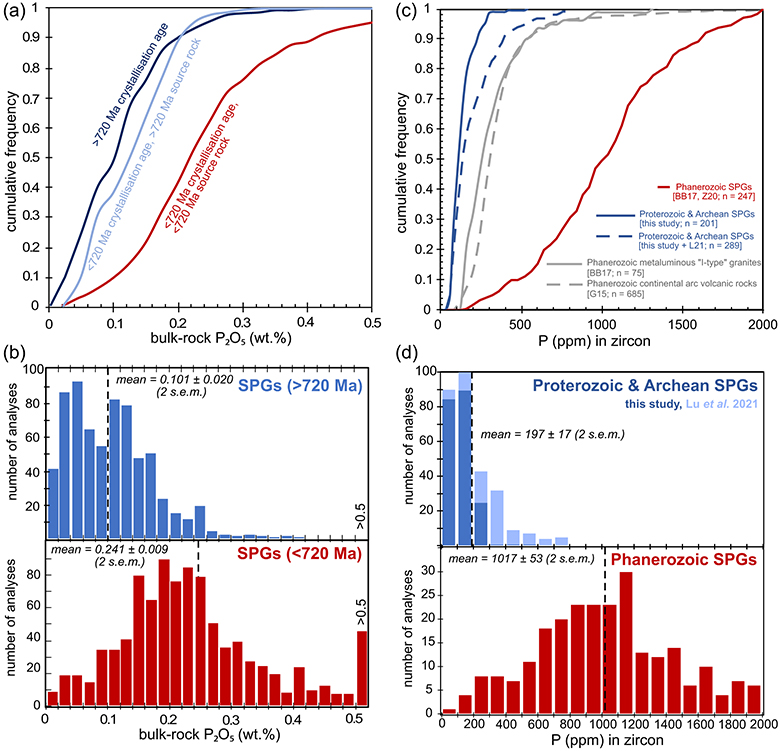
Figure 1 (a) Cumulate frequency distributions of SPG bulk rock P2O5. (b) Histograms of SPG bulk rock P2O5 with source rock and crystallisation ages >720 Ma (top) and <720 Ma (bottom). Data in (a) and (b) from Bucholz (2022)
Bucholz, C.E. (2022) Coevolution of sedimentary and strongly peraluminous granite phosphorus records. Earth and Planetary Science Letters 596, 117795. https://doi.org/10.1016/j.epsl.2022.117795
. (c) Cumulative frequency distributions of P in zircon for Proterozoic and Archean SPGs, as well as Phanerozoic SPGs, “I-type” granites, and continental arc volcanic rocks. (d) Histograms of zircon P concentrations for Proterozoic/Archean SPGs and Phanerozoic SPGs. Phanerozoic SPG and I-type granite data in (c) and (d) are from Burnham and Berry (2017)Burnham, A.D., Berry, A.J. (2017) Formation of Hadean granites by melting of igneous crust. Nature Geoscience 10, 457–461. https://doi.org/10.1038/ngeo2942
and Zhu et al. (2020)Zhu, Z., Campbell, I.H., Allen, C.M., Burnham, A.D. (2020) S-type granites: Their origin and distribution through time as determined from detrital zircons. Earth and Planetary Science Letters 536, 116140. https://doi.org/10.1016/j.epsl.2020.116140
and continental arc volcanic zircon from Grimes et al. (2015)Grimes, C.B., Wooden, J.L., Cheadle, M.J., John, B.E. (2015) “Fingerprinting” tectono-magmatic provenance using trace elements in igneous zircon. Contributions to Mineralogy and Petrology 170, 46. https://doi.org/10.1007/s00410-015-1199-3
.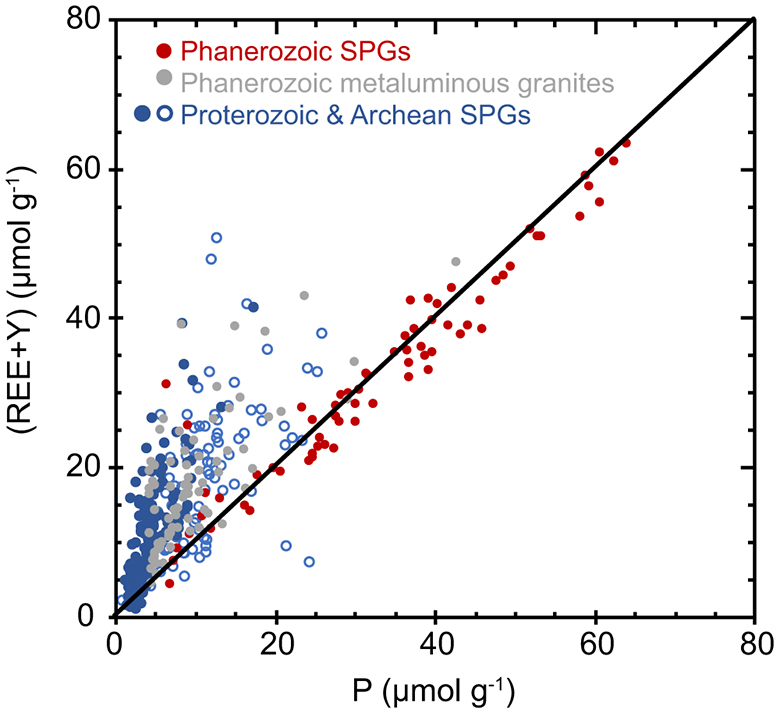
Figure 2 REE + Y versus P (in μmol/g) in zircon. Phanerozoic granite data are the same as in Figure 1. Proterozoic and Archean SPGs are from this study (filled symbols) and Lu et al. (2021)
Lu, G.-M., Spencer, C.J., Tian, Y., Wang, W. (2021) Significant Increase of Continental Freeboard During the Early Paleoproterozoic: Insights From Metasediment‐Derived Granites. Geophysical Research Letters 48, e2021GL096049. https://doi.org/10.1029/2021GL096049
(open symbols).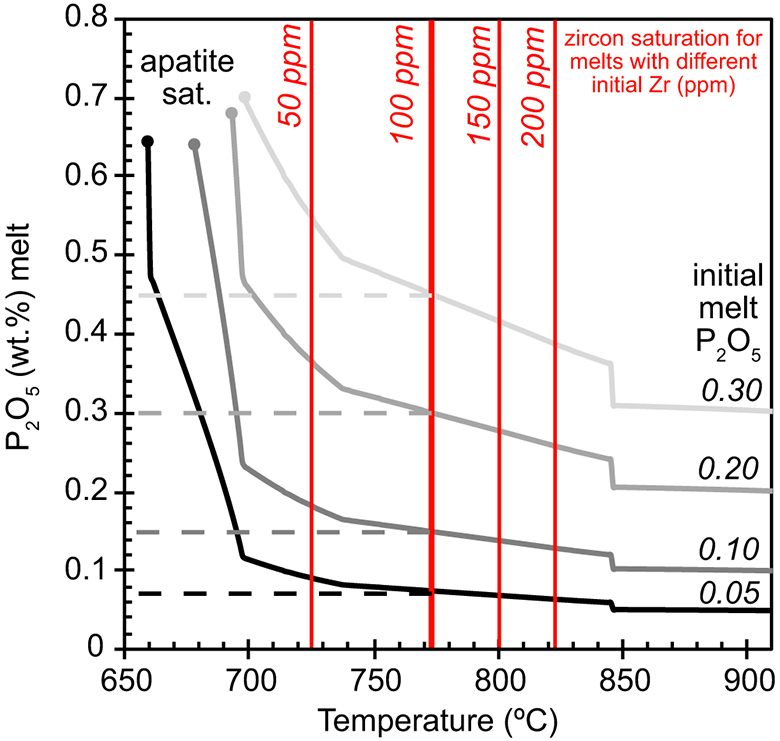
Figure 3 Model results for melt P2O5 (wt. %) versus temperature during crystallisation of a SPG melt for different initial melt P2O5 (wt. %). Melt trajectories end once apatite saturation is reached. Zircon saturation temperatures are indicated with vertical red lines.


